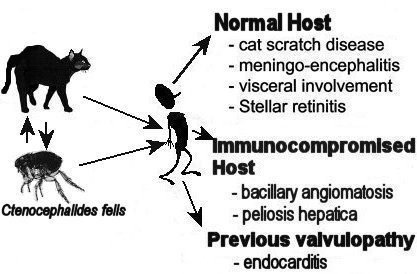Cat Scratch Disease Transmission
Henselae can result in CSD in immunocompetent humans and bacillary angiomatosis in immunosuppressed. The disease spreads when an infected cat licks a persons open wound or bites or scratches a person hard enough to break the surface of the skin.

Flea Associated Zoonotic Diseases Of Cats In The Usa Bartonellosis Flea Borne Rickettsioses And Plague Trends In Parasitology
The term cat scratch disease incorrectly implies that cats are the only source of transmission and infection.

. Cat scratch disease CSD is caused by a bacterium called Bartonella henselae which may be carried in the saliva of infected cats and in the bodies of cat fleas. Symptoms typically include a non-painful bump or blister at the site of injury and painful and swollen lymph nodes. The predominant clinical feature of CSD.
Henselae is spread among catsthe principal mammal reservoir speciesby the cat flea Ctenocephalides felis. Cat scratch disease CSD has an estimated prevalence of approximately 200000 persons in the USA and approximately 22000 new cases occur annually. 1Community Outreach Clinic in Menomonee Falls Wis USA.
About three to 14 days after the skin is broken a mild infection can occur at the site of the scratch or bite. Henselae and other Bartonella species that can cause human disease some people infected with Bartonella have no history of a cat scratch or bite wound and others have had no known. Some evidence suggests that CSD may be spread directly to people by the bite of infected cat fleas although this has not been proven.
Cat Scratch Disease Other Names. As the name implies this bacterial infection is usually transmitted from cat to human via scratches although it can also be transmitted via bite wounds and when a cat licks the open wounds of a person. Transmission seems to be a result of a scratch bite lick or other exposure to a healthy usually young cat.
Cat-Scratch Diseasediagnosis Cat-Scratch Diseaseetiology. Cat Scratch Disease Transmission. Stray cats may be more likely than pets to carry Bartonella.
It is a fairly common bacterial infection with a. Other animals such as dogs monkeys rabbits chickens and horses may be possible sources but this is not confirmed. Cat-scratch disease or felinosis is an infectious disease that most often results from a scratch or bite of a cat.
Cat-scratch disease CSD is an uncommon illness that can be transmitted to people by cats. Over 90 of patients report a history of recent contact with cats or kittens which usually appear healthy. Kittens younger than one are more likely to carry B.
These bacteria can be transmitted from a cat to a person during a scratch. Transmission to humans occurs via scratches and possibly bites from cats. Cat scratch disease CSD is transmitted by the bite or scratch of a cat infected with the microorganism Bartonella henselae.
Cats likely contract the bacteria from infected fleas. The fact that people only so rarely contract cat scratch disease after a cat scratch is due to the transmission routes. CSD occurs worldwide wherever cats live.
Infected cats can transmit the illness to people even if the cats do not show any signs or symptoms of illness. Cat scratch disease is associated with cat scratches although cat bites and licks can often lead to CSD too with more than 90 of those infected have a history of contact. It is also commonly known as cat scratch disease CSD or cat scratch fever This is a zoonotic disease meaning that it can be transmitted between animals and humans.
Cat-Scratch Disease diagnosis. The usual method of transmission appears to be inoculation of the agent at the site of a cat scratch but other possible methods of transmission such as inhalation of the agent are substantiated by the several reported cases with a history of contact with cats but with no definite history of a scratchDaniels and MacMurray in 1954 reported an. Cat Scratch Fever Benign Inoculation Lymphoreticulosis Benign Inoculation Reticulosis Regional Granulomatous Lymphadenitis Parinauds Oculoglandular Syndrome Bacillary Angiomatosis Bartonellosis.
Transmissible Cat Disease. It becomes infected while sucking blood and passes the pathogen on to its next four-legged victim. Although many cases of CSD follow a scratch from a cat and cats are a major reservoir for B.
Cat scratch disease is caused by Bartonella which is transmitted through cat bites or scratches but also through flea or tick bites. In most cases the immune system renders Bartonella harmless before symptoms appear. 12400315 Indexed for MEDLINE Publication Types.
In very rare instances humans can contract the bacteria directly from fleas. Zoonotic transmission of B. The bacterium is excreted through the flea and into its feces which it leaves on the cats skin.
Symptoms typically begin within 314 days following infection. In cats the disease is generally transmitted through contact with flea feces. The agent that causes cat-scratch disease is a rickettsial bacteria-like organism called Bartonella henselae.
Cat-Scratch Disease etiology. Cat scratch disease CSD is a bacterial infection spread by cats. 103848 PubMed - indexed for MEDLINE MeSH Terms.
Cat-Scratch Disease transmission. People may feel tired have a headache or a fever. The cat flea acts as the main carrier between cats.
What is cat scratch disease. Cat-scratch disease is caused by the. Also known as cat scratch fever subacute regional lymphadenitis or Teenys disease cat scratch disease CSD is a self-limiting zoonotic infection transmitted from animals to humans.
In the United States most cases of CSD occur in the. Cats are the natural carriers of Bartonella henselae the agent for CSD. Cat scratch disease CSD is a zoonosis caused by Bartonella henselae a fastidious hemotropic Gram-negative bacterium.


No comments for "Cat Scratch Disease Transmission"
Post a Comment